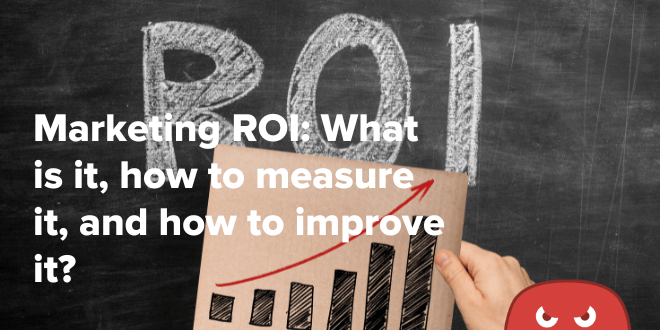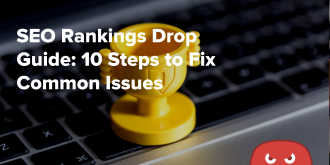Quick Links
Companies launch multiple marketing campaigns across varying platforms every year. All of these campaigns require money to pay for production, promotion, and labor. So, how do companies know that the investment is worth it?
They look at ROI or return of investment. It helps them compare the money they’ve generated for every dollar they’ve spent on marketing.
Marketing ROI (MROI) is calculated to help marketers and stakeholders understand if a campaign is worth the marketing spend.
A successful campaign is one where revenue is greater than the marketing expense. Even in an unsuccessful campaign, MROI and related metrics can help identify where things went wrong so marketers don’t repeat their mistakes.
This article will take a deep dive into marketing ROI, explain what it is, how to calculate it, and why it’s so challenging for marketers to get definite numbers.
What Is Marketing ROI?
Marketing return on investment (ROI) or (MROI) is a term used to define the profit or revenue generated compared to the amount of money spent.
Businesses and marketers can look at the overall ROI, aka overall sales, revenue, or profit, or they can consider other valuable benefits such as increased website traffic, higher search ranking, and more brand awareness.
In the second scenario, marketers often look at metrics by different channels, like email, social media, and SEO, to track progress and see if their campaigns are successful.
There are different ways to ascertain marketing ROI. The most common ones are:
Revenue: The total revenue generated from all your marketing activities.
ROAS: Return on Ad Spend (ROAS) measures how much revenue was generated compared to every dollar spent on advertising.
Sales cycle days: The number of days a user takes to complete the sales cycle, from becoming aware of your brand to buying a product. The fewer the sales cycle days, the better.
Cost per acquisition (CPA) ratio: An average of how much a brand needs to spend to acquire a new customer.
Duration of Engagement: How long a customer stays engaged with your brand or a particular campaign. Measuring this helps marketers identify which part of the sales funnel needs optimization.
Customer lifetime value (CLTV): The customer’s overall value to your company over their time with your brand. Marketers often compare this with CPA to understand how much profit a customer generates vs. the cost of acquiring them.
These are some of the many metrics that a marketer has to keep track of during a campaign. Often, businesses run multiple campaigns, and these metrics indicate which ones are worth continuing.
Why is marketing ROI important?
Calculating the return on marketing investment is crucial for understanding whether their marketing activity is successful or not. Here’s how:
- Indicates the performance of your campaign
The MROI shows how a campaign is actually doing. At the end of the day, shareholders and leadership are focused on the money. If your campaign is generating leads, but few of them are converting into customers, leadership might decide to end the campaign.
MROI rounds out your campaign assessment by helping you look past false promises of success garnered by incomplete or standalone metrics like lead volume or click rate. Relying only on these could lead to bad marketing decisions.
- Identify the most effective marketing channels
MROI helps marketers clearly see which channels are the most effective for each campaign. They can then optimize their marketing efforts by creating and promoting content suitable for the best channels.
- Optimize marketing budget distribution
Marketing heads have a finite budget to work with. Using MROI metrics, they can allot funds to channels and campaigns with a proven track record of success. They can also decide on future marketing budgets and spending.
For example, if a specific new campaign needs additional investment to get off the ground, the budget for that month or quarter will have to be moved around.
- Secure further marketing investment
Giving stakeholders a clear picture of progress will ease their fears and add to your credibility. MROI can be used to prove campaign success and secure funding for future marketing programs or additional funding for existing ones.
How To Calculate Marketing ROI
To calculate the overall marketing ROI, you can use this formula:
Marketing ROI = (Sales Growth or Revenue Generated − Marketing Cost) / Marketing Cost
For example, if sales grew by $5000 and the marketing campaign cost $500, the ROI is 900%. However, most marketing efforts look past this simple marketing ROI formula.
In most cases, marketers use direct or indirect revenue attribution to calculate ROI. In direct attribution, marketers credit the entire revenue to the last marketing element a customer interacted with before their purchase.
For indirect attribution, marketers evenly distribute the revenue across all the marketing channels that a customer interacts with.
You can also use a hybrid model to identify the channels generating the most leads and the channels that have the most conversions.
Marketers can use other more complex formulas to track ROI during the course of a campaign. For example, you can use this one to measure MROI. To calculate the ROI mid-way through the sales cycle:
Marketing ROI = [((number of leads x lead-to-customer rate x average sales price) – cost or ad spend) ÷ cost or ad spend] x 100.
Since marketing channels don’t have hard numbers, it’s best to also account for:
- Time spent: How much time it took to launch or complete a campaign from inception to its current stage.
- Production Costs: How much money you spend creating assets used in the campaign.
- Page Analytics: How users interact with your website.
- Non-financial returns: Good results that are not financial include an increase in engagement, website traffic, and brand awareness.
The Challenges of Calculating Marketing ROI
If you’re new to MROI, you’ll likely make the mistake of thinking calculating MROI involves collecting data and then using them in formulas. But it’s not that simple. In fact, proving ROI was the second biggest challenge for marketers in 2021.
It’s hard to concretely nail down marketing ROI since attributing a lead to a specific channel is difficult, despite improvements in tools and technologies.
For example, let’s say you have a social media marketing campaign that brings a user to your website, who then takes days or weeks to interact with various other content marketing elements (such as a video, newsletter, or webinar) before completing the purchase.
In this case, attributing the lead or revenue to any one channel could be a mistake. Instead, you could use statistics related to these channels to make a call.
For example, 78% of customers in a 2021 survey said watching a video convinced them to buy or download a software or app.
But, this doesn’t mean that video was the primary lead generation tool for YOUR campaign.
The best way to measure marketing ROI is on a long-term basis. This means marketers often look past the hard numbers gathered during the initial stages of a campaign and focus on other improvements, such as audience growth or engagement levels, to track success.
Marketing ROI Benchmarks Across Different Channels
Since marketers have to look at metrics across different channels to gauge campaign success, here are a few key channels to track ROI on.
Email marketing ROI
Email is well-known to be the channel with the highest ROI, with studies estimating that emails generate a return of $36 on average for every $1 spent. As a result, this is an essential marketing channel for most businesses.
You can measure the ROI for this channel by tracking key email marketing KPIs, such as open rates, click-through rates, and bounce rates.
For example, you can place unique tracking URLs in the CTA buttons of your emails. So, when you send a limited-time offer in a marketing email, it’s easy to see which users clicked on the link and used the code to complete the purchase.
Social media ROI
Social media ROI goes beyond definite numbers like leads generated or website traffic. Marketers have to track engagement metrics instead. These include likes, comments, followers, and page views.
Engagement metrics help you understand if your marketing is impactful and resonating with your audience. If your posts are not garnering any interactions, it’s a sign that you need to pivot and maybe even try out paid promotions or sponsored posts.
For example, let’s say you’re a SaaS company that posts about a free trial of their platform on all your social media channels. The link to this promotion is a tracking URL. Using this URL, you can track which platforms garnered the most sign-ups.
On the social media channels themselves, you can also track engagement. So, an increase in likes could indicate that customers are fans of the promotion. You can use this to create follow-up posts asking for reviews or thoughts in the comments. These comments then prove to future users that your app is worth checking out.
PPC campaigns ROI
PPC or Pay-per-click campaigns are when marketers use paid advertising to increase brand reach. In this method, the company pays a specific amount every time a user clicks on their ad. On Google, your ads can be placed on search engines, YouTube videos, and on different websites.
Here’s an example of a search ad:
Marketers can heavily customize ads to target specific user demographics and keywords. Once the ads are out there, it’s up to the marketers to analyze and optimize the landing pages they lead to.
Measuring ad metrics includes tracking website traffic, leads generated, and conversions. These numbers can help you identify bumps in your sales funnel. For example, if you see a repetitive pattern of users that click on your ad but then leave your landing page, it’s time to optimize your landing page.
Ad-based metrics like the revenue generated are also important. Marketers often calculate the return on ad spend (ROAS) to see if the campaign is working, needs optimization, or is not worth continuing.
Content marketing ROI
Every content marketing strategy includes different content types, platforms, and individual metrics for each platform. Blogs, videos, guest posts, social media posts, and more fall under the content marketing umbrella.
The ultimate goal of content marketing is higher search engine rankings. The MROI for content marketing tracks leads, conversions, and each channel’s metrics.
For example, if blogging is a part of your strategy, then the number of views and shares each blog generates indicates whether the plan is working or not.
Video marketing ROI
Video marketing has become essential in every strategy. In a 2021 survey, 92% of marketers say they consider video to be an “important part” of their marketing strategy.
Whether you’re a B2C or B2B business, videos are crucial for explaining your products and promoting them. This is why the survey found that explainer videos and social media videos were the most common types used by marketers.
Video marketing ROI relies on the number of views, watch time, shares, click-through rates, and conversions.
For example, a plumbing channel with tutorial videos that garners thousands of views but very few actual website visitors or leads will have a poor marketing ROI. It indicates the need to localize your content so the people around you can use your services. Local SEO could also help.
Sponsored content ROI
Sponsored content is used to promote your products or services. Typically, companies pay an advertiser, influencer, or publisher to create and share content related to their brand. Paid reviews on social media or YouTube are a popular example of this.
Sponsored content aims to create engagement. Customers are more likely to check out your product if an influencer they trust gives it a glowing review. Metrics here are harder to measure since increased engagement doesn’t always mean increased sales.
Sponsored content ROI is typically calculated by comparing the cost of hiring an influencer or publisher to the number of leads or conversions their video or post generated.
For example, if the influencer charges $1000 per post, but their followers purchase $3000 worth of products, the investment is well worth it.
In many cases, marketers don’t track direct conversions from sponsored content, but they track click-through rates from the publisher’s post.
Customer Lifetime Value and Customer Acquisition Cost
Customer Lifetime Value (CLV) indicates how much an average customer spends on your products or services throughout their time as your customer. It’s a key marketing ROI metric since most companies these days look past the first transaction and want to develop brand loyalty.
When it comes to MROI, comparing CLV to customer acquisition cost is a better indicator of your brand’s success. Customer acquisition cost (CAC) is the average amount you spend on getting a new customer.
Your CAC:CLV ratio is the key indicator of business success. Some experts estimate that 5:1 is a good ratio for most businesses, while 10:1 is exceptional.
So, if it takes $400 to acquire a new customer on average, but this customer is expected to spend upwards of $2000 over the next few weeks or months, then the ratio is 5:1, and your marketing campaign is working.
A lower ratio means your marketing is struggling to develop brand loyalty and needs to be changed.
Get an Accurate MROI and Improve on It
Marketing ROI is often not a straightforward calculation since it relies on many smaller metrics. Marketing and revenue go hand in hand, so ignoring marketing metrics like increased engagement, website traffic, or higher search rankings would be a mistake.
However, marketers need to see the big picture and relate their marketing to revenue generation. Many companies fail to track vital metrics and make poor decisions based on just leads and conversions. Rather than optimization and continued marketing, they tend to eliminate and start over. This is expensive and not always needed.
If you want your marketing campaigns to be handled by a team of experts, get in touch with The HOTH today!














